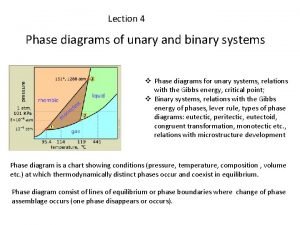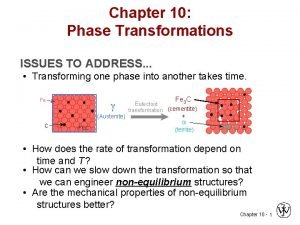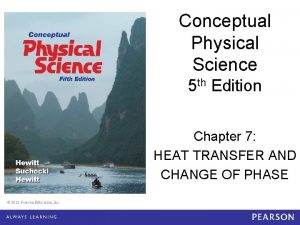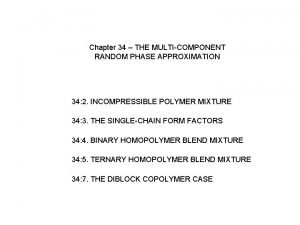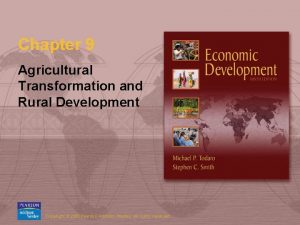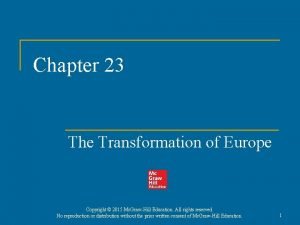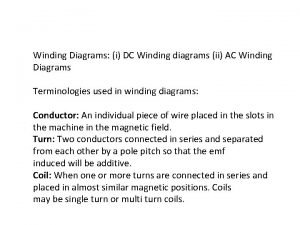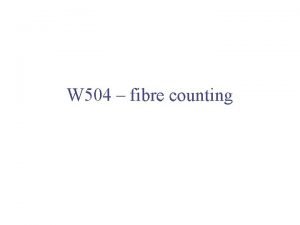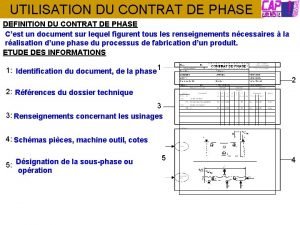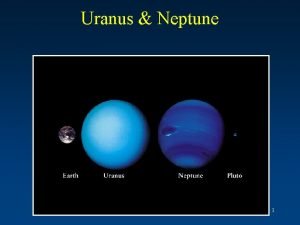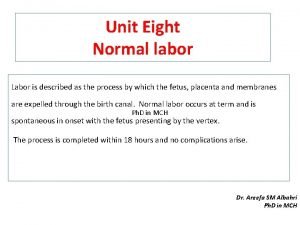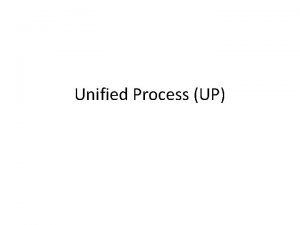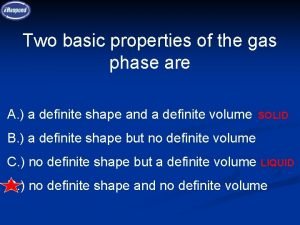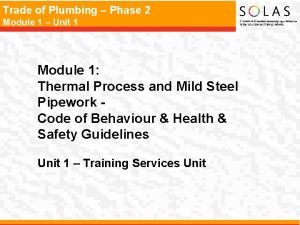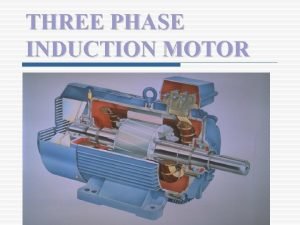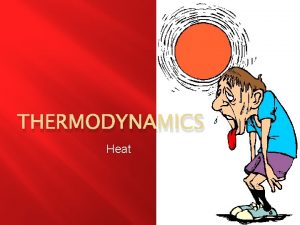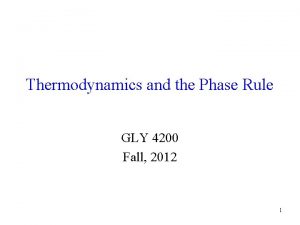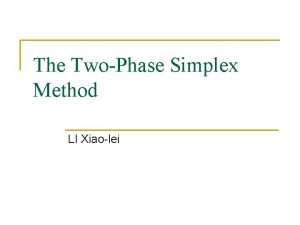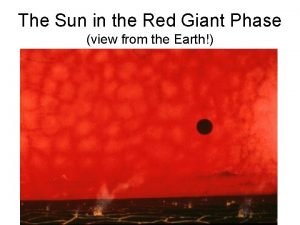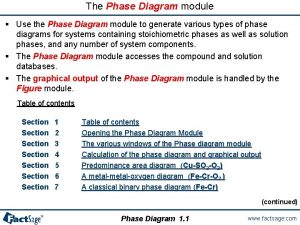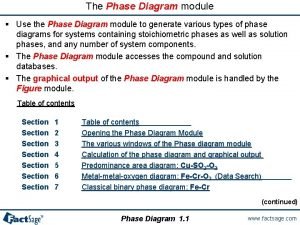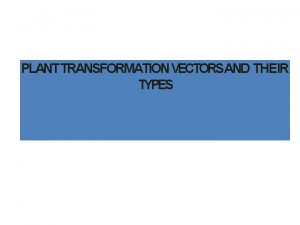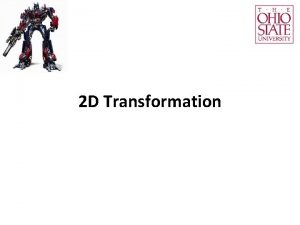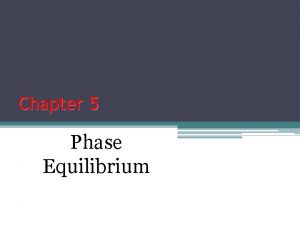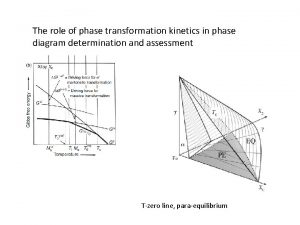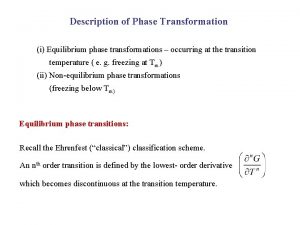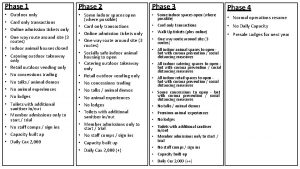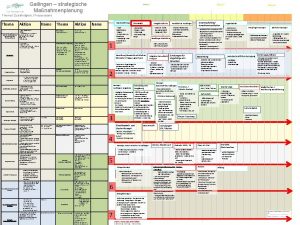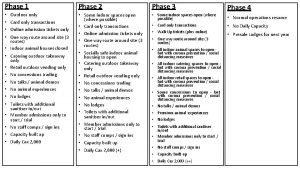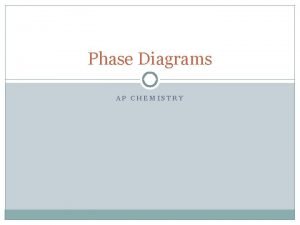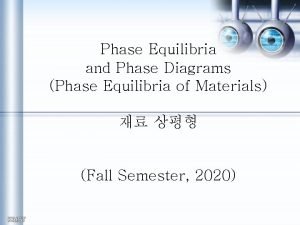Phase Transformation Chapter 9 Q How was the




















































































- Slides: 84

Phase Transformation Chapter 9

Q: How was the statue made? A: Invest casting Liquid-to-solid transformation An example of phase transformation Shiva-Parvati, Chola Bronze Ball State University

How does one produce single crystal of Si for electronic applications? Czochralski crystal pulling technique

Quenching of steel components a solid->solid phase transformation

Solid state phase ion at fic di so li evaporation Liquid at condensation m bli me transformation su lti ng Solid 1 gas Solid 2

Thermodynamic driving force for a phase transformation? Decrease in Gibbs free energy Liquid-> solid gs - gl = g = -ve

g Gibbs free energy as a function of temperature, Problem 2. 3 g. L g. S g g. L < g. S Solid is stable g. S < g. L Liquid is stable g. S g. L Tfreezing Tm T Fig. 9. 1

How does solidification begins? Usually at the walls of the container Heterogeneous nucleation. Why? To be discussed later.

Spherical ball of solid of radius R in the middle of the liquid at a temperature below Tm Homogeneous nucleation r g. L = free energy of liquid per unit volume g. S = free energy of solid per unit volume g = g. S - g. L

Change in free energy of the system due to formation of the solid ball of radius r : + 4 p r 2 g +ve: barrier to nucleation r r* r

Solid balls of radius r < r* cannot grow as it will lead to increase in the free energy of the system !!! + 4 p r 2 g Solid balls of radii r > r* will grow r* is known as the CRITICAL RADIUS OF HOMOGENEOUS NUCLEATION r* r

+ 4 p r 2 g Eqn. 9. 4 r* r Eqn. 9. 5

Driving force for solidification g g (T) g. L T Tm g. S T Eqn. 9. 7

f + 4 p r 2 g Fig. 9. 3 f 1* + 4 p r 2 g f 2* r 2 * r 1* r Eqn. 9. 7 T 2 < T 1 Eqn. 9. 8

Comparison of Nucleation & Capillary Rise Nucleation Capillary Rise S V R R* V G=S+V Unstable Equilibrium E=S+V H H* S Stable Equilibrium 15

Nucleation Capillary Rise Driving Force Volume free energy (R 3) Surface energy (H) Opposing Force Surface energy (R 2) Volumetric gravitational potential (H 2) Equilibrium Unstable Stable R. Prasad, “On Capillary Rise and Nucleation”, Journal of Chemical Education, Vol. 85, No. 10, October 2008, p 1389 16

Journal of Chemical Education, Vol. 85, No. 10, October 2008, p 1389 17

HETEROGENEOUS NUCLEATION Nucleation is often aided by some preexisting surfaces, e. g. , container walls, grain boundaries etc. Such nucleation is called HETEROGENEOUS NUCLEATION Pepsi experiment 18

Orthophosphoric Acid Demonstration Phosphoric acid, used in many soft drinks (primarily cola), has been linked to lower bone density in epidemiological studies. -Wikipedia Homogeneous vs. heterogeneous nucleation Cloud seeding and artificial rain 19

20

Atoms surrounding the critical particle Formation of critical nucleus by statistical fluctuation Critical particle Diffuse jump of a surrounding atom to the critical particle makes it a nucleation Fig. 9. 4



Plot of S( ) r*


Eqn. 9. 9 s*= no. of liquid phase atoms facing the critical sized particle Hd = activation energy for diffusive jump from liquid to the solid phase = atomic vibration frequency The rate of successful addition of an atom to a critical sized paticle Eqn. 9. 10

Rate of nucleation, I , (m 3 s-1) = No. of nucleation events per m 3 per sec = number of critical clusters per unit volume (N*) x rate of successful addition of an atom to the critical cluster ( ’) T With decreasing T Tm 1. Driving force increases 2. Atomic mobility decreases I

Growth Increase in the size of a product particle after it has nucleated T U

Overall Transformation Kinetics I: Nucleation rate (m-3 s-1) T U: Growth rate (ms-1) Overall transformation rate (fraction transformed per second, s-1) X=fraction of product phase U d. X/dt I

Fraction transformed as a function of time X Slow due to final impingement Slow due to very few nuclei ts tf t

TTT Diagram for liquid-to-solid transformation X 1 0 T T Tm ts tf log t Stable liquid Cgins e b n es o i v t r a z u i c all Cryst L+ nds e n o i t a iz Crystall crystal Under Cooled liquid d. X/dt log t

TTT Diagram for liquid-to-solid transformation T U T Tm I Stable liquid Under Cooled liquid L+ Fine grained crystals Coarse grained crystals glass log t

T ts metals ts Si. O 2 Metallic glass Silica glass Eqn. 9. 11 Eqn. 9. 8 Hd ∝ log (viscosity) log t Si. O 2: low hm, high viscosity Metals: high hm, low viscosity

Inert gas pressure Quartz tube Melt Spinning for metallic glass ribbons Molten alloy Heater coil Jet of molten metal Ribbon of glassy metal Rotating cooled metal drum Cooling rate 106 ºC s-1 From Principles of Electronic Materials and Devices, Second Edition, S. O. Kasap (© Mc. Graw-Hill, 2002) http: //Materials. Usask. Ca

Tm Log (viscosity Pa-s) T L+ crystal 30 log t glass 18 Fig. 9. 17 12 Undercooled liquid Stable liquid Tg Tm T

Specific volume Stable liquid Undercooled liquid Fast cool Fig. 9. 18 Slow cool crystal Tgs Tgf Tm T

T Glass ceramics Stable liquid Undercooled liquid Tm L+ devitrification glass crystal T TU TI U T log t Liquid growth Very fine crystals nucleation Fig. 9. 16 I glass Glass ceramic time

Corningware Pyroceram. TM heat resistant cookware Corning’s new digital hot plates with Pyroceram. TM tops. ROBAX® was heated until redhot. Then cold water was poured on the glass ceramic from above - with NO breakage.

Czochralski crystal pulling technique for single crystal Si J. Czochralski, (1885 -1953) Polish Metallurgist SSPL: Solid State Physics Laboratory, N. Delhi

TABLE 9. 2 Hardness Wt% C Steel Rockwell C Microstructure Heat treatment Annealing A 15 0. 8 Coarse pearlite B 30 0. 8 fine pearlite normalizing C 45 0. 8 bainite austempering quenching D 55 0. 8 Tempered martensite E 65 0. 8 martensite

HEAT TREATMENT Heating a material to a high temperature, holding it at that temperature for certain length of time followed by cooling at a specified rate is called heat treatment

holding heati ng T AT Q T A N Annealing Furnace cooling RC 15 Normalizing Air cooling RC 30 Quenching Water cooling RC 65 Tempering Heating after quench RC 55 Austempering Quench to an intermediate temp and hold RC 45 time

Eutectoid Reaction 0. 8 cool 0. 02 6. 67 Pearlite Ammount of Fe 3 C in Pearlite Red Tie Line below eutectoid temp

Phase diagrams do not have any information about time or rates of transformations. We need TTT diagram for austenite-> pearlite transformation

TTT diagram for eutectoid steel Stable austenite t r sta unstable austenite finish

TTT diagram for eutectoid steel T U Stable austenite rt a t s I unstable austenite finish Annealing: coarse pearlite Normalizing: fine pearlite

Callister

QUENCHING TTT diagram for eutectoid steel Hardness RC 65 Stable austenite t r sta ’: martensite (M) Extremely rapid, no Ccurves Ms : Martensite start Ms temperature Mf : Martensite finish Mf temperature unstable austenite A+M M finish

Martensitic transformation Amount of martensite formed does not depend upon time, only on temperature. Atoms move only a fraction of atomic distance during the transformation: 1. Diffusionless (no long-range diffusion) BCT 2. Shear (one-to-one correspondence between and ’ atoms) 3. No composition change

Martensitic transformation (contd. ) Problem 3. 1 BCT unit cell of (austenite) BCT unit cell of ’ (martensite) Expand ~ 12% Contract ~ 20% Fig. 9. 12 0% C (BCC) 1. 2 % C

Martensitic transformation (contd. ) Hardness of martensite as a function of C content Hardness, RC 60 40 Fig. 9. 13 20 0. 2 0. 4 0. 6 Wt % Carbon → Hardness of martensite depends mainly on C content and not on other alloying additions

heati ng T AT Q T A N

TEMPERING Heating of quenched steel below the eutectoid temperature, holding for a specified time followed by ar cooling. T<TE ?

Tempering (contd. ) +Fe 3 C PEARLITE A distribution of fine particles of Fe 3 C in matrix known as TEMPERED MARTENSITE. Hardness more than fine pearlite, ductility more than martensite. Hardness and ductility controlled by tempering temperature and time. Higher T or t -> higher ductility, lower strength

Tempering Continued Callister

Austempering Bainite Short needles of Fe 3 C embedded in plates of ferrite

Problems in Quenching Quench Cracks High rate of cooling: surface cooler than interior Surface forms martensite before the interior Austenite martensite Volume expansion When interior transforms, the hard outer martensitic shell constrains this expansion leading to residual stresses

Solution to Quench cracks Shift the C-curve to the right (higher times) More time at the nose Slower quenching (oil quench) can give martensite But how to shift the C-curve to higher times?

By alloying All alloying elements in steel (Cr, Mn, Mo, Ni, Ti, W, V) etc shift the C-curves to the right. Exception: Co Substitutional diffusion of alloying elements is slower than the interstitial diffusion of C

Plain C steel Alloying shifts the C-curves to the right. Separate C-curves for pearlite and bainite Fig. 9. 10

Hardenability Ability or ease of hardening a steel by formation of martensite using as slow quenching as possible Alloying elements in steels shift the C-curve to the right Alloy steels have higher hardenability than plain C steels.

Hardnenability Ability or ease of hardening a steel Only applicable to steels Hardness Resistance to plastic deformation as measured by indentation Applicable to all materials Alloying additions increase the hardenability of steels but not the hardness. C increases both hardenability and hardness of steels.

High Speed steel Alloy steels used for cutting tools operated at high speeds Cutting at high speeds lead to excessive heating of cutting tools This is equivalent to unintended tempering of the tools leading to loss of hardness and cutting edge Alloying by W gives fine distribution of hard WC particles which counters this reduction in hardness: such steels are known as high speed steels.

Tsolvus : solid solution of Cu in FCC Al + : intermetallic compound Cu. Al 2 supersaturated FCC 4 wt%Cu 4 saturated FCC 0. 5 wt%Cu + Tetragonal 54 wt%Cu Precipitation of in

Tsolvus Stable TTT diagram of precipitation of in unstable start finsh + Asquench ed Aging A fine distribution of precipitates in matrix causes hardening Completion of precipitation corresponds to peak hardness

As quenched Aged -grains + Driving force for coarsening / interfacial energy Peak aged Dense distribution of fine overaged Sparse distribution of coarse

hardness Aging temperature 100ºC 20ºC 180ºC Fig. 9. 15 Aging time 0. 1 1 10 100 (days) Peak hardness is less at higher aging temperature Peak hardness is obtained in shorter time at higher aging temperature

T Stable U Tsolvus unstable start finsh + 180 ºC Asquenched I 100 ºC Aging hardness 100ºC 180ºC 1 20ºC

Recovery, Recrystallization and grain growth Following slides are courtsey Prof. S. K Gupta (SKG) Or Prof. Anandh Subramaniam (AS)

Plastic deformation in the temperature range above(0. 3 – 0. 5) Tm → COLD WORK ↑ point defect density Cold work ↑ dislocation density q Point defects and dislocations have strain energy associated with them q (1 -10) % of the energy expended in plastic deformation is stored in the form of strain energy AS

↑ Strength ↑ Hardness Cold work ↑ Electrical resistance ↓ Ductility AS

Cold work Anneal Recovery Recrystallization Grain growth AS

Recovery, Recrystallization and Grain Growth During recovery 1. Point Defects come to Equilibrium 2. Dislocations of opposite sign lying on a slip plane annihilate each other (This does not lead to substantial decrease in the dislocation density) SKG

POLYGONIZATION Bent crystal Po lyg on Low angle grain boundaries iza tio n AS

Recrystallization Strained grains Strain-free grains Driving force for the Process = Stored strain energy of dislocations SKG

Recrystallization Temperature: Temperature at which the 50% of the cold-worked material recrystallizes in one hour Usually around 0. 4 Tm (m. p in K) SKG

Factors that affect the recrystallization temperature: 1. Degree of cold work 2. Initial Grain Size 3. Temperature of cold working 4. Purity or composition of metal Solute Drag Effect Pinning Action of Second Phase Particle SKG

Solute Drag Effect SKG

Grain Boundary Pinning SKG

Grain Growth Increase in average grain size following recrystallization Driving Force reduction in grain boundary energy Impurities retard the process SKG

Grain growth q Globally ► Driven by reduction in grain boundary energy q Locally ► Driven by bond maximization (coordination number maximization) AS

AS Bonded to 4 atoms Bonded to 3 atoms Direction of grain boundary migration Boundary moves towards its centre of curvature JUMP

Hot Work and Cold Work q Hot Work Plastic deformation above TRecrystallization Hot Work Plastic deformation below TRecrystallization temperature (~ 0. 4 Tm) Cold Work q Cold AS

Electical conductivity Internal stress Ductility Tensile strength Cold work %CW Recovery Recrystallization Grain growth Annealing Temperature Fig. 9. 19 AS
 Normal phase vs reverse phase chromatography
Normal phase vs reverse phase chromatography Hplc reverse phase vs normal phase
Hplc reverse phase vs normal phase Mobile phase and stationary phase
Mobile phase and stationary phase Stationary and mobile phase
Stationary and mobile phase Normal phase vs reverse phase chromatography
Normal phase vs reverse phase chromatography Difference between phase voltage and line voltage
Difference between phase voltage and line voltage Detectors used in hplc
Detectors used in hplc In a triangle connected source feeding a y connected load
In a triangle connected source feeding a y connected load Broad phase vs narrow phase
Broad phase vs narrow phase Unary diagram
Unary diagram Calister
Calister Hình ảnh bộ gõ cơ thể búng tay
Hình ảnh bộ gõ cơ thể búng tay Lp html
Lp html Bổ thể
Bổ thể Tỉ lệ cơ thể trẻ em
Tỉ lệ cơ thể trẻ em Voi kéo gỗ như thế nào
Voi kéo gỗ như thế nào Thang điểm glasgow
Thang điểm glasgow Hát lên người ơi
Hát lên người ơi Môn thể thao bắt đầu bằng từ chạy
Môn thể thao bắt đầu bằng từ chạy Thế nào là hệ số cao nhất
Thế nào là hệ số cao nhất Các châu lục và đại dương trên thế giới
Các châu lục và đại dương trên thế giới Công thức tính thế năng
Công thức tính thế năng Trời xanh đây là của chúng ta thể thơ
Trời xanh đây là của chúng ta thể thơ Mật thư tọa độ 5x5
Mật thư tọa độ 5x5 101012 bằng
101012 bằng độ dài liên kết
độ dài liên kết Các châu lục và đại dương trên thế giới
Các châu lục và đại dương trên thế giới Thể thơ truyền thống
Thể thơ truyền thống Quá trình desamine hóa có thể tạo ra
Quá trình desamine hóa có thể tạo ra Một số thể thơ truyền thống
Một số thể thơ truyền thống Bàn tay mà dây bẩn
Bàn tay mà dây bẩn Vẽ hình chiếu vuông góc của vật thể sau
Vẽ hình chiếu vuông góc của vật thể sau Nguyên nhân của sự mỏi cơ sinh 8
Nguyên nhân của sự mỏi cơ sinh 8 đặc điểm cơ thể của người tối cổ
đặc điểm cơ thể của người tối cổ V. c c
V. c c Vẽ hình chiếu đứng bằng cạnh của vật thể
Vẽ hình chiếu đứng bằng cạnh của vật thể Fecboak
Fecboak Thẻ vin
Thẻ vin đại từ thay thế
đại từ thay thế điện thế nghỉ
điện thế nghỉ Tư thế ngồi viết
Tư thế ngồi viết Diễn thế sinh thái là
Diễn thế sinh thái là Dạng đột biến một nhiễm là
Dạng đột biến một nhiễm là Các số nguyên tố là gì
Các số nguyên tố là gì Tư thế ngồi viết
Tư thế ngồi viết Lời thề hippocrates
Lời thề hippocrates Thiếu nhi thế giới liên hoan
Thiếu nhi thế giới liên hoan ưu thế lai là gì
ưu thế lai là gì Khi nào hổ mẹ dạy hổ con săn mồi
Khi nào hổ mẹ dạy hổ con săn mồi Sự nuôi và dạy con của hổ
Sự nuôi và dạy con của hổ Sơ đồ cơ thể người
Sơ đồ cơ thể người Từ ngữ thể hiện lòng nhân hậu
Từ ngữ thể hiện lòng nhân hậu Thế nào là mạng điện lắp đặt kiểu nổi
Thế nào là mạng điện lắp đặt kiểu nổi Chapter 23 change of phase
Chapter 23 change of phase Chapter 7 heat transfer and change of phase
Chapter 7 heat transfer and change of phase Conceptual physics chapter 17 change of phase answers
Conceptual physics chapter 17 change of phase answers Phase chapter 34
Phase chapter 34 Chapter 9 agricultural transformation and rural development
Chapter 9 agricultural transformation and rural development Chapter 9 agricultural transformation and rural development
Chapter 9 agricultural transformation and rural development Chapter 23 the transformation of europe
Chapter 23 the transformation of europe Concentric winding diagram
Concentric winding diagram Sample atkins diet phase 1
Sample atkins diet phase 1 Advantages of phase contrast microscope
Advantages of phase contrast microscope Contrat de phase usinage
Contrat de phase usinage Neptune uranus
Neptune uranus Equillibria
Equillibria Hypertonic vs hypotonic uterine dysfunction
Hypertonic vs hypotonic uterine dysfunction Elaboration phase of unified process combines
Elaboration phase of unified process combines Data collection planning in the measure phase starts with
Data collection planning in the measure phase starts with Two basic properties of the gas phase are
Two basic properties of the gas phase are Etiotropic phase
Etiotropic phase Ehrz regime
Ehrz regime Phase 2 plumbing
Phase 2 plumbing Line vs phase voltage
Line vs phase voltage Line currents
Line currents How induction motor starts
How induction motor starts What is the third step of the nursing process
What is the third step of the nursing process Phase change formula
Phase change formula Gibbs phase rule
Gibbs phase rule Contoh visioning
Contoh visioning Two phase simplex method
Two phase simplex method Red giant phase
Red giant phase Two phase simplex method
Two phase simplex method Stability diagrams module
Stability diagrams module Sgte phase diagram
Sgte phase diagram









